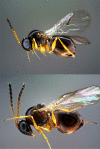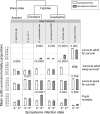Independent origins of resistance or susceptibility of parasitic wasps to a defensive symbiont
- PMID: 27066241
- PMCID: PMC4798148
- DOI: 10.1002/ece3.2085
Independent origins of resistance or susceptibility of parasitic wasps to a defensive symbiont
Abstract
Insect microbe associations are diverse, widespread, and influential. Among the fitness effects of microbes on their hosts, defense against natural enemies is increasingly recognized as ubiquitous, particularly among those associations involving heritable, yet facultative, bacteria. Protective mutualisms generate complex ecological and coevolutionary dynamics that are only beginning to be elucidated. These depend in part on the degree to which symbiont-mediated protection exhibits specificity to one or more members of the natural enemy community. Recent findings in a well-studied defensive mutualism system (i.e., aphids, bacteria, parasitoid wasps) reveal repeated instances of evolution of susceptibility or resistance to defensive bacteria by parasitoids. This study searched for similar patterns in an emerging model system for defensive mutualisms: the interaction of Drosophila, bacteria in the genus Spiroplasma, and wasps that parasitize larval stages of Drosophila. Previous work indicated that three divergent species of parasitic wasps are strongly inhibited by the presence of Spiroplasma in three divergent species of Drosophila, including D. melanogaster. The results of this study uncovered two additional wasp species that are susceptible to Spiroplasma and two that are unaffected by Spiroplasma, implying at least two instances of loss or gain of susceptibility to Spiroplasma among larval parasitoids of Drosophila.
Keywords: Braconidae; Drosophila melanogaster; Figitidae; Mollicutes; defensive mutualism; heritable endosymbiont.
Figures



Similar articles
-
Generality of toxins in defensive symbiosis: Ribosome-inactivating proteins and defense against parasitic wasps in Drosophila.PLoS Pathog. 2017 Jul 6;13(7):e1006431. doi: 10.1371/journal.ppat.1006431. eCollection 2017 Jul. PLoS Pathog. 2017. PMID: 28683136 Free PMC article.
-
Male killing Spiroplasma protects Drosophila melanogaster against two parasitoid wasps.Heredity (Edinb). 2014 Apr;112(4):399-408. doi: 10.1038/hdy.2013.118. Epub 2013 Nov 27. Heredity (Edinb). 2014. PMID: 24281548 Free PMC article.
-
The Role of Lipid Competition for Endosymbiont-Mediated Protection against Parasitoid Wasps in Drosophila.mBio. 2016 Jul 12;7(4):e01006-16. doi: 10.1128/mBio.01006-16. mBio. 2016. PMID: 27406568 Free PMC article.
-
The defensive Spiroplasma.Curr Opin Insect Sci. 2019 Apr;32:36-41. doi: 10.1016/j.cois.2018.10.004. Epub 2018 Oct 23. Curr Opin Insect Sci. 2019. PMID: 31113629 Review.
-
The role of defensive symbionts in host-parasite coevolution.Biol Rev Camb Philos Soc. 2018 Nov;93(4):1747-1764. doi: 10.1111/brv.12417. Epub 2018 Apr 16. Biol Rev Camb Philos Soc. 2018. PMID: 29663622 Review.
Cited by
-
Generality of toxins in defensive symbiosis: Ribosome-inactivating proteins and defense against parasitic wasps in Drosophila.PLoS Pathog. 2017 Jul 6;13(7):e1006431. doi: 10.1371/journal.ppat.1006431. eCollection 2017 Jul. PLoS Pathog. 2017. PMID: 28683136 Free PMC article.
-
Differential gene expression in a tripartite interaction: Drosophila, Spiroplasma and parasitic wasps.PeerJ. 2021 Mar 4;9:e11020. doi: 10.7717/peerj.11020. eCollection 2021. PeerJ. 2021. PMID: 33717711 Free PMC article.
-
Functional genomics of a Spiroplasma associated with the carmine cochineals Dactylopius coccus and Dactylopius opuntiae.BMC Genomics. 2021 Apr 6;22(1):240. doi: 10.1186/s12864-021-07540-2. BMC Genomics. 2021. PMID: 33823812 Free PMC article.
-
Effect of heritable symbionts on maternally-derived embryo transcripts.Sci Rep. 2019 Jun 20;9(1):8847. doi: 10.1038/s41598-019-45371-0. Sci Rep. 2019. PMID: 31222094 Free PMC article.
-
Experimental Evolution as an Underutilized Tool for Studying Beneficial Animal-Microbe Interactions.Front Microbiol. 2016 Sep 13;7:1444. doi: 10.3389/fmicb.2016.01444. eCollection 2016. Front Microbiol. 2016. PMID: 27679620 Free PMC article. Review.
References
-
- Asplen, M. K. , Bano N., Brady C. M., Desneux N., Hopper K. R., Malouines C., et al. 2014. Specialisation of bacterial endosymbionts that protect aphids from parasitoids. Ecol. Entomol. 39:736–739.
-
- Bensadia, F. , Boudreault S., Guay J. F., Michaud D., and Cloutier C.. 2006. Aphid clonal resistance to a parasitoid fails under heat stress. J. Insect Physiol. 52:146–157. - PubMed
-
- Bolaños, L. M. , Servín‐Garcidueñas L. E., and Martínez‐Romero E.. 2015. Arthropod‐Spiroplasma relationship in the genomic era. FEMS Microbiol. Ecol. 91:1–8. - PubMed
-
- Carton, Y. , Boulétreau M., van Alphen J. J. M., and van Lenteren J. C.. 1986. The Drosophila parasitic wasps Pp. 347–394 in Ashburner M., Carson H. L., and Thompson J. N., ed. The genetics and biology of Drosophila. Academic Press, London.
LinkOut - more resources
Full Text Sources
Other Literature Sources
Molecular Biology Databases

